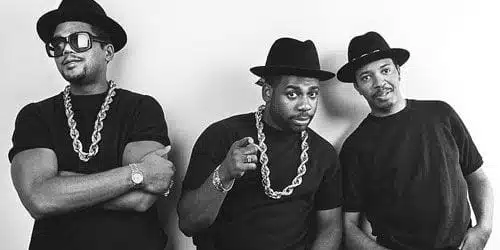
When you look back on Run-DMC’s career, especially their epochal first three albums, one word stands out.
Rock.
Because Run-DMC understood, like none of their hip-hop predecessors or contemporaries did, that hip-hop and rap music was just as much a product of early Black American roots music as rock ‘n’ roll was. Rap added elements of Jamacian soundsystem music as well, with MCs layering their lyrics over R&B, funk, and dub-derived music. Listen to Sugarhill Gang’s landmark “Rapper’s Delight”. The backing track is from a Chic song. Even innovative classics by Grandmaster Flash and the Furious Five and Whodini relied on electro-funk templates for their music. Run-DMC stripped all that away. They reduced rap to its essential elements, beats and rhymes. In doing so, they built it up into a musical form that was just as powerful as rock ‘n’ roll on a visceral level.
It is no coincidence that two of the standout tracks on the two-disc, 29-song The Essential Run-DMC feature the work “rock”. “Rock Box”, from Run-DMC (1984), and the title track from King of Rock (1985) take the beats ‘n’ rhymes approach and add screaming heavy metal guitar riffs. This was not pandering. The explosive electronic beats and authoritative brashness of the lyrics are too mean, too badass to pander. If the guitars made white suburban kids sit up and pay attention, well, it was just a sign of the times. At their peak, Run-DMC did not stoop down to being a rock band. They brought rock up to their level.
The work of Joseph “Run” Simmons, Darryl “DMC” McDaniels, and Jason “Jam Master Jay” Mizell has been anthologized before in a couple of serviceable greatest hits albums. If you really want the essential Run-DMC, though, you will seek out Run-DMC, King of Rock, and Raising Hell (1986) in full. All of them are available in deluxe, remastered versions, and together they comprise one of the boldest, most enduring statements in either rock or rap history. What is a collection like The Essential Run-DMC, spanning the trio’s entire seven-album run, good for, then? If nothing else, it illustrates that Run-DMC’s career followed an arc that was very much in keeping with rock ‘n’ roll tradition.
Fully half the material on The Essential Run-DMC is devoted to the golden period from 1983-1986. The live “Here We Go” from 1983 shows the trio had established their singular sound even before they released an album. Over Jay’s hard-hitting beat and scratching, Run and DMC lay down their stark yet inventive rhymes. Still in their teens, the two MCs have already honed their mic skills, and their inimitable deliveries are fully-formed. McDaniels, in particular, had one of the baddest, most intimidating voices in hip-hop history. If Samuel L. Jackson, in his pre-self caricature days, had rapped, he would have sounded something like this. “Hard Times” showcases Run-DMC’s penchant for straightforward social commentary, while “Sucker M.C.’s” and “It’s Like That” project bold self-confidence that runs far deeper than pat braggadocio. Jay’s backing consists of little more than a drum machine and occasional synth stabs. Run and DMC, meanwhile, literally yell into the microphone. Forget flow, these guys could orate.
From King of Rock, the title track and “You Talk Too Much” show each member’s skills sharpening. The pinnacle is reached on Raising Hell. Run-DMC went all in on their status as a true rock ‘n’ roll band by drafting in Steven Tyler and Joe Perry for a rollicking cover of “Walk This Way”, a move that helped resurrect Aerosmith’s career as well as give Run-DMC their first true crossover hit. “You Be Illin'” and “It’s Tricky” are examples of Run-DMC’s newfound, more whimsical pop smarts, probably a result of Rick Rubin’s arrival as co-producer. But “My Adidas” and the devastating “Peter Piper” show the band had not lost their minimalist ethos, or their edge. If anything, The Essential Run-DMC would have benefitted by including more of Raising Hell‘s harder side, such as the title track or “Proud to Be Black”.
Run-DMC are often credited with helping invent “hardcore” or “gangsta” rap. No doubt, their sound was hard and they pulled no punches and certainly influenced the likes of NWA and 50 Cent along the way. But it is important to remember their message contradicted the adversarial posturing and rampant sexism that would come to be synonymous with gangsta rap. They preached self-empowerment and bragged about going to college. “Dumb Girl” chides a girl for giving in to gender stereotypes, instead of reinforcing them by judging her: “I wish I knew why a girl like you / Wants to do all the things that you do … / … There’s something you’re missing that money can’t buy”.
Having reached the top of the mountain, creatively and commercially, Run-DMC then followed the path many other rock bands take in similar situations. They tumbled down, occasionally hitting on solid ground but mostly flailing, eventually ending up in a heap of acrimony and reality TV. Half of The Essential Run-DMC chronicles this slow fall, though the non-chronological ordering tries to camouflage it. “They Call US Run-DMC” and “Come on Everybody” still hit hard, but for the most part the band are bringing in producers and guests to help ape the very acts they inspired. Call it the innovator’s curse. The dreadful “School of Old” from 2001 swan song Crown Royal is the nadir, featuring Kid Rock and sounding like bad Limp Bizkit. Think about just what a fall that indicates.
The Essential Run-DMC does indeed include many essential classics. But it also forces you to juxtapose these against weaker latter-day material in an unflattering way. Without exception, the early material has stood the test of time better than the post-Raising Hell material.
Run-DMC proved a hip-hop band could rock just as hard as anyone. In the process, they emphasized the true meaning of what rock ‘n’ roll is, and broadened the scope of what hip-hop was. Kings of Rock indeed.

